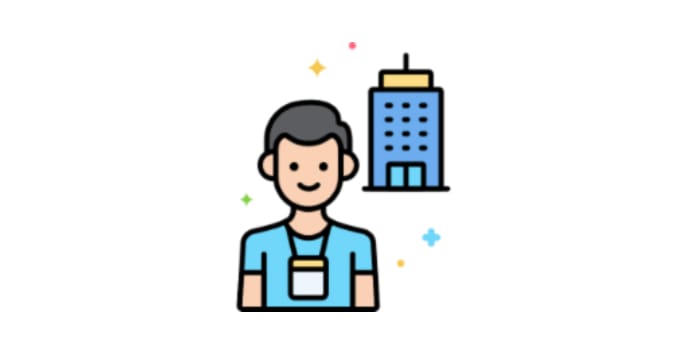Do you have an interest in web programming? Do you identify with the phrase "jack of all trades"? If you answered yes, then becoming a full-stack developer might be a good career choice for you!
A full-stack developer is someone who works on both the front-end and back-end of websites and web applications. In plainer terms, this type of developer is concerned with what web app users see and interact with and the functionality they don't see, like communication among web browsers, servers, and databases. (We'll explain these differences in more detail later.)
There are several good reasons to consider going into full-stack development:
- You can make a good living
- Demand for this role is evergreen and even expected to continue growing, even with current hiring freezes
- You can tackle increasingly intriguing challenges and solve real-world problems
To enter a new profession, you generally need to start by doing some research and self-analysis. Full-stack development is no exception. To help you understand this step and all the others in the journey ahead, we've made a roadmap. As you read it, you will:
- Find answers to big questions about becoming a full-stack developer
- Learn a structured approach to preparing to join the ranks of full-stack devs
- Encounter resources for learning more about this occupation
A smaller map: We've been down the full-stack road before with a JavaScript-focused guide. But today, we'll provide a more complete career roadmap with step-by-step instructions and a more comprehensive list of skills to learn.
Your journey will be unique, and not everything in this article will resonate with you. You'll also find that some of our answers are a bit vague due to the variability of individual career paths. But by the time you finish reading, we think you'll have a clearer sense of the road you'll be traveling.
Let's go!
We'll cover:
- Steps to becoming a full-stack developer
- How long does it take to become a full-stack developer?
- Requirements to become a full-stack developer
- How much does a full-stack developer make?
- What to do next to become a full-stack developer
Steps to becoming a full-stack developer
Before we begin, we need to acknowledge something. Your journey into this field will not look like, say, your developer friend's journey, just as theirs didn't match those of their predecessors. What you already know how to do and how you learned those skills will influence the steps you take. But shared standards exist despite this variation, and many developers and software engineers have taken certain actions to reach their goals. Let's take a look at those actions now.
Step 0: Understand full-stack development
We offered a quick definition of full-stack development earlier, but it's worth another look. If you're committing to this occupation, then understanding the distinction between front-end development and back-end development is important because you will do both.
The functionality of websites and web apps depends on working code on both ends. Front-end developers work on user interfaces (UI) and what web apps do on the client side. That means everything that users see and interact with on end-user devices. Back-end developers concern themselves with what web apps do on the server side. That typically involves the dynamic display of information that is transmitted from a database on a server to that end-user device. Becoming either a front-end developer or back-end developer requires plenty of education and training. In some ways, becoming a full-stack developer requires even more.
Some basic technologies and skills form the foundation that all three kinds of developers build upon. But front-end and back-end roles require some specialization, too. You'll find an overview of these combined skills and other requirements for becoming a full-stack developer as you continue reading.
Step 1: Make a plan
You should kick off your journey with research and planning. For starters, consider the fundamental decision of how you want to get the required education and training. Learning the skills to become a full-stack developer will require a lot of time and energy, so you'll want to carefully consider your options. Many aspiring developers pursue a degree in computer science or a related field, which may be what some employers prefer. But you can certainly launch a coding career without such a degree. Other options are to attend a bootcamp, earn a university certificate, or study on your own.
Be aware: Not having a CS degree could set you up initially for more junior roles, often with titles like junior or associate developer.
It's hard to say how long this step will take you. Suffice it to say, don't take shortcuts in your planning and research. Your decisions will form the foundation for everything that follows, especially what comes next: completing your education.
Step 2: Get an education
We're now going to compare your various educational options and their pros and cons. As we said earlier, you can choose between a degree program or other options, but you'll be hard-pressed to start a full-stack developer career without some kind of education.
Time estimate: This step could take anywhere from 12 weeks to six years, excluding the time you spend applying to and waiting to start a program.
Step 3: Get real-world experience
Employers are often reluctant to hire developers who haven't proven themselves in previous roles. But if you're just starting out, your work history may not contain much relevant experience. Where can you find the practical opportunities you need?
Luckily, you've got some options. You can work toward your goal of getting hired for that first developer role by:
- Going through an internship program
- Joining hackathons
- Writing quality code for projects you attempt yourself or as a contributor to open-source projects
If you're in a degree program or a bootcamp, you'll often have access to resources for uncovering these kinds of opportunities. If you're studying solo, you'll need to do the research yourself.
Check out these resources:
- Developing a professional brand
- Upgrading your resume
- Keeping coding projects on track
- Helping out on open-source projects
You should definitely preserve your efforts on these real-world endeavors in a portfolio, which you can later showcase to potential employers.
Time estimate: This step may require several months, but you can take on as many of these pursuits as possible while you get your education.
Step 4: Earn a certification (optional)
You can bolster your credentials by earning a software development certification. You may not be able to do this during or immediately after your education, because some providers require previous software development experience from candidates. But certifications are worth considering down the road as a way to advance your career.
Full-stack developers could explore the following general software development certifications:
- Certified Secure Software Lifecycle Professional
- Professional Software Developer
- CIW Web Development Professional
- GIAC Certified Web Application Defender (GWEB)
In addition, other certifications cater more to the back-end side of the skillset:
- C/C++ Certified Professional Programmer
- Oracle certifications (e.g., SQL, MySQL, Database development)
- Certified Professional in Python Programming 1 Certification
Time estimate: Since many certifications are designed for experienced developers, it might take several years to finish this step. Exam preparation time will also need to be factored into your planning.
Step 5: Prepare for your job search
The internet makes it easy to search for jobs. But before submitting your first application, consider making the following preparations to set yourself up for success.
- Polish your portfolio: With a free GitHub account, you can maintain the code from your individual and open-source projects in repositories that recruiters and potential employers can view. (As an added advantage, you’ll get hands-on experience with version control, an important skill for any developer.)
- Do mock interviews: Take some time to study common coding problems, technical questions, and behavioral questions and practice how you might answer them.
- Network: Connecting to established developers and companies you might apply to can help you learn about the interview process, company quirks, and other tips. Resources like alumni groups, LinkedIn, and other social networks will make connecting easier.
Time estimate: You won't regret investing a few weeks to a few months in these activities.
Step 6: Search for full-stack developer jobs
When you feel prepared, take a deep breath, and start your job search. You can research and apply for open positions using websites like ZipRecruiter, Dice, Glassdoor, Indeed, etc. Job application software or a spreadsheet can help you track all your applications and their different statuses.
Time estimate: Don't be surprised if you spend several months applying for jobs and interviewing, especially in the current climate, where hiring freezes are not uncommon. Be prepared for interviews that can span multiple rounds over four weeks or more. Also, try not to take rejection personally, which we know is easier said than done. Plenty of successful developers have navigated long job searches before securing a position. In addition, interviewing is a skill, and the longer you practice it, the more likely you are to improve and nail your next interview.
How long does it take to become a full-stack developer?
You might need anywhere from three months to six years to become a full-stack developer. Your timeline will be influenced by:
- What you already know (especially technical skills)
- What jobs you've held (and their relevance to the field)
- What education you've attained (and its relevance to web development)
- Your career aspirations
- The state of the job market
With some existing technical skills, experience, and a degree in computer science or a related field, you might be able to become a full-stack developer after a few months of looking in a strong market. Without those skills, that experience, and that degree, you could be facing a much longer road, especially in a less healthy market.
We've said that how you acquire your technical education will affect your timeline to obtaining a full-stack developer job. As with back-end developer positions, potential employers may prefer candidates with CS degrees for full-stack roles, so keep that in mind. But that's not a hard and fast rule, and coding bootcamp grads or self-paced learners can also launch careers in full-stack development.
Preparing to search for a job after finishing your education will require additional time, as will making sure you've met the requirements for joining the ranks of professional full-stack developers.
Requirements to become a full-stack developer
Education, real-world experience, and a technical skillset are all requirements for becoming a full-stack developer. The precise nature of these requirements will depend on your personal background and goals.
Education
At this point, you should have a good idea of your education options. A CS degree might make sense for pursuing this line of work, given many employers' preferences. But as we've noted, you can pursue learning in other ways as long as you pick up the essential concepts and skills for this work.
Applicable experience
As with many related roles, aspiring full-stack developers may face challenges getting hired without previous hands-on experience in the field. But those just starting out can acquire some experience through other activities, like:
- Internships at tech companies: Solve problems and contribute to real-world applications while networking with experienced professionals.
- Professional certifications: Show off your proficiency and dedication by passing exams on various software development topics.
Technical skills
Even more than front-end or back-end specialists, aspiring full-stack developers must have robust technical skill-sets. That's because these skills must encompass both sides of web development. As you study, you'll pick up a lot of what you'll need to know. But don't rely solely on your instructors to equip you. Instead, you might embrace the scrappiness of a self-taught developer and continue learning on your own. As far as what you need to know, we've divided relevant skills into categories of front-end, back-end, and advanced.
Essential front-end skills
- Logical reasoning
- How the internet works (e.g., clients, servers, networks, webpages)
- HTML, CSS, and web development basics
- Front-end programming languages and frameworks (e.g. JavaScript, React, Angular, jQuery)
- Version control systems (Git + repository services like GitHub)
- Web security standards
- RESTful APIs and services
- Testing and debugging (e.g., Unit testing, functional testing, usability testing, performance testing, regression testing)
- Graphic design
Essential back-end skills
- Back-end programming languages (e.g., JavaScript, Python, PHP, Java, C++)
- The JavaScript runtime environment Node.js
- Back-end web frameworks (e.g., Django and Flask for Python, Laravel for PHP)
- Relational databases (e.g., PostgreSQL, MySQL)
- NoSQL databases (e.g., MongoDB, Cassandra, Firebase)
- Application programming interfaces (APIs) (e.g., REST, JSON APIs, SOAP, gRPC)
- Data structures and algorithms
Putting the "stack" in "full-stack": You'll also need to be familiar with various tech stacks for web development and their pros and cons. While you could eventually learn them all, it's best to start with just one stack and master its components.
Advanced skills
- Other JS frameworks (e.g, NextJS, Gatsby, NuxtJS)
- Advanced database knowledge (e.g., ORMs, ACID, Transactions, N+1 problem, database normalization, indexes, data replication, sharding strategies, CAP Theorem)
- Continuous integration and continuous deployment (CI/CD) practices
- Architectural patterns (e.g., monolithic apps, microservices, SOA, CQRS and event sourcing, serverless)
- System design concepts
- Message brokers (e.g. Kafka, RabbitMQ)
- Containerization vs virtualization (e.g., Docker, Kubernetes)
- GraphQL (e.g., Apollo, Relay Modern)
- Graph databases (e.g., Neo4j)
- Web sockets
- Web servers (Apache, NGINX, Caddy, MS IIS)
Soft skills and qualities
Finally, if you want to excel in the workplace, you shouldn't neglect soft skills and behavioral qualities. You can cultivate these six characteristics central to becoming an outstanding developer.
- A desire to build and create
- A team mindset
- Creative problem-solving skills
- Empathy
- Determination
- A love of learning
Job interviews will give you opportunities to demonstrate these qualities, but don't forget about them after getting an offer. By continuing to work on these skills, you'll help establish a strong reputation in the workplace.
How much does a full-stack developer make?
You can earn good money as a full-stack developer, as with many of the best-paying careers in tech. The Bureau of Labor Statistics reports that the median pay for web developers in the United States in 2020 was $77,200 per year ($37.12 per hour). These are median figures and a couple of years old, of course, so your actual salary or wage could be different. Also, keep in mind that your salary can grow as you gain experience, earn certifications, and achieve promotions.
In addition, those BLS figures might not reflect the total compensation for web developers. According to Glassdoor, an American website that compiles information about jobs and salaries, the estimated total pay for a web developer in the United States is $110,356 per year, based on an average salary of $72,495. The remaining compensation could come from cash bonuses, commissions, and profit sharing.
Compensation is certainly important, but you'll also want to consider the demand for full-stack developers. Web developer jobs are expected to increase 13 percent from 2020 to 2030 in the United States, according to BLS projections, which is faster than the average for all occupations. You can also search for "full-stack developer jobs" on Indeed, Glassdoor, Dice, Zip Recruiter, etc., to see the kinds of positions available. Your search results will not be nearly as comprehensive as the government's data, but you'll be seeing real-world job descriptions at the same time. In addition, Glassdoor presents salary estimates for specific companies using anonymous data from current and former employees.
What to do next to become a full-stack developer
The road to becoming a full-stack developer can seem daunting if you're just starting out. But at least you should now know what awaits you: the steps to complete, the amount of time it might take, the skills you'll need to learn, and what you might expect to earn. If you're ready to start, consider reviewing Step 1 of this roadmap and making your plan.
Once that's in hand, you should be prepared to start learning! No matter what educational route you'll take, you can begin building your technical skills immediately with Educative's interactive development courses.
Your success as a full-stack developer will depend on mastering skills for the front-end and back-end of websites and web applications. To help you learn front-end skills, we've created the learning path Become a Front-End Developer, which covers markup and styling with HTML and CSS, interactivity with JavaScript, and launching a website. If you want to focus on the back end, consider the learning path Fundamentals of Web Programming. It teaches basic programming skills in C++ and back-end essentials like databases and networks. It will also familiarize you with HTML, CSS, and JavaScript if you need that.
Happy learning!
Continue learning about full-stack development on Educative
- How to choose the right tech stack for web development
- A quick dive into Firebase: jumpstart your full-stack journey
- Can I become a full-stack Python developer?
Start a discussion
Why are you intrigued by a career as a full-stack developer? Was this article helpful? Let us know in the comments below!


















Top comments (1)
To become a full-stack developer, you need to have a strong understanding of both front-end and back-end technologies. Joining a comprehensive training program like Acaders can provide you with the necessary skills and knowledge to excel in this field. Acaders offers specialized courses that cover front-end development with HTML, CSS, and JavaScript, as well as back-end development with popular frameworks like Java, Python, or Node.js. With hands-on projects, industry-relevant curriculum, and guidance from experienced instructors, **Acaders **can help you gain the expertise needed to become a successful full-stack developer.Their pay after placement and 100% placement guarantee ensure that you have the best opportunities for employment after completing the course.